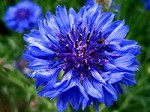 Also known as bluebottle, bluet, bluecap, and cornflower, this cool weather annual is a member of the aster family, Asteraceae, that also includes daisy, sunflower, and lettuce. It is native to Europe where it is now endangered in some areas due to habitat destruction, but was introduced into North America where it has done well and has become invasive in the Northwest because of its tendency to self seed. The narrow plants grow 1-3′ tall and have numerous gray-green branches and lanceolate leaves. The 1-1.5″ wide flowerheads are comprised of many small ray flowers around a center of disc flowers and held together by an involucre of overlapped bracts. The flowers bloom from late spring throughout the summer in cool climates and are usually bright lavender blue but cultivars in pink, rosy red, and white are available. Plants like full sun with afternoon shade and average, moist, well-drained soil. USDA Hardiness Zones 1-11 (Photo Credit Wikipedia)
Also known as bluebottle, bluet, bluecap, and cornflower, this cool weather annual is a member of the aster family, Asteraceae, that also includes daisy, sunflower, and lettuce. It is native to Europe where it is now endangered in some areas due to habitat destruction, but was introduced into North America where it has done well and has become invasive in the Northwest because of its tendency to self seed. The narrow plants grow 1-3′ tall and have numerous gray-green branches and lanceolate leaves. The 1-1.5″ wide flowerheads are comprised of many small ray flowers around a center of disc flowers and held together by an involucre of overlapped bracts. The flowers bloom from late spring throughout the summer in cool climates and are usually bright lavender blue but cultivars in pink, rosy red, and white are available. Plants like full sun with afternoon shade and average, moist, well-drained soil. USDA Hardiness Zones 1-11 (Photo Credit Wikipedia)
The following natives are recommended alternatives:
Quamash (Camassia spp.)
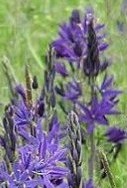 Also called Indian hyacinth, wild hyacinth, camash, and camas, this perennial bulb is native to the Pacific Northwest where it grows in moist mountain meadows. Plants form a clump 2′ across and 3-4′ tall of strap-shaped leaves up to 2′ long. In late spring terminal racemes of 20-80 star-shaped flowers appear above the foliage, opening sequentially from the bottom. Each flower has 6 petal-like tepals and varies in color from white or pale lilac to deep purple or blue-violet. USDA Hardiness Zones 5-9 (Photo Credit Wikipedia)
Also called Indian hyacinth, wild hyacinth, camash, and camas, this perennial bulb is native to the Pacific Northwest where it grows in moist mountain meadows. Plants form a clump 2′ across and 3-4′ tall of strap-shaped leaves up to 2′ long. In late spring terminal racemes of 20-80 star-shaped flowers appear above the foliage, opening sequentially from the bottom. Each flower has 6 petal-like tepals and varies in color from white or pale lilac to deep purple or blue-violet. USDA Hardiness Zones 5-9 (Photo Credit Wikipedia)
Harebell (Campanula rotundifolia)
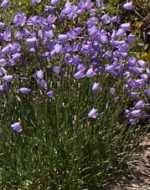 Also known as the bluebell of Scotland, harebell is a rhizomatous herbaceous perennial found in many of the cooler regions of North America and Europe where it grows in dry, nutrient-poor grasslands, savannas, prairies, and heaths, often in rock crevices, cliff faces, and dunes. Plants form a basal rosette of 1″ wide rounded toothed leaves on long petioles. In summer several unbranched wiry flowering stems arise from each rosette bearing 2-3″ long grass-like leaves and carrying terminal flowers singly or in clusters. The bell-shaped flowers are nodding, blue, and 1/2 to 1″ wide. USDA Hardiness Zones 2-7 (Photo Credit Wikipedia)
Also known as the bluebell of Scotland, harebell is a rhizomatous herbaceous perennial found in many of the cooler regions of North America and Europe where it grows in dry, nutrient-poor grasslands, savannas, prairies, and heaths, often in rock crevices, cliff faces, and dunes. Plants form a basal rosette of 1″ wide rounded toothed leaves on long petioles. In summer several unbranched wiry flowering stems arise from each rosette bearing 2-3″ long grass-like leaves and carrying terminal flowers singly or in clusters. The bell-shaped flowers are nodding, blue, and 1/2 to 1″ wide. USDA Hardiness Zones 2-7 (Photo Credit Wikipedia)
Larkspur (Consolida ajacis)
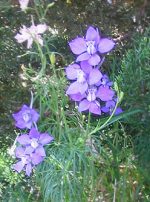 Also called doubtful knight’s spur and rocket larkspur, this herbaceous cool weather annual
Also called doubtful knight’s spur and rocket larkspur, this herbaceous cool weather annualDwarf Mountain Fleabane (Erigeron compositus)
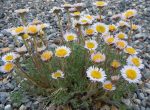 Also known as cutleaf daisy and trifid mountain fleabane, this herbaceous rhizomatous perennial is an Arctic and alpine species found in western US from Alaska, south through the Rockies and Dakodas, west to California and New Mexico where they grow on cliffs rocky slopes and talus, as well as in woodland edges, meadows and plains. Plants have a stout taproot and spread by rhizomes to form small clumps. They grow up to 10″ tall and have thick unbranched green or red hairy stems bearing a clump of hairy 2″ long leaves that are finely divided into linear lobes. In summer, flowerheads are carried singly on almost leafless stems and consist of 20-60 white, pink or blue ray flowers around a center of several dozen yellow disc flowers. Two or three rows of green or purple bracts covered with white hairs surround each flowerhead. USDA Hardiness Zones 2-7 (Photo Credit: Wikipedia)
Also known as cutleaf daisy and trifid mountain fleabane, this herbaceous rhizomatous perennial is an Arctic and alpine species found in western US from Alaska, south through the Rockies and Dakodas, west to California and New Mexico where they grow on cliffs rocky slopes and talus, as well as in woodland edges, meadows and plains. Plants have a stout taproot and spread by rhizomes to form small clumps. They grow up to 10″ tall and have thick unbranched green or red hairy stems bearing a clump of hairy 2″ long leaves that are finely divided into linear lobes. In summer, flowerheads are carried singly on almost leafless stems and consist of 20-60 white, pink or blue ray flowers around a center of several dozen yellow disc flowers. Two or three rows of green or purple bracts covered with white hairs surround each flowerhead. USDA Hardiness Zones 2-7 (Photo Credit: Wikipedia)
Wandering Fleabane (Erigeron peregrinus)
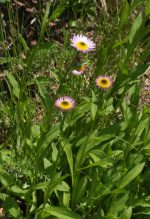 Native to bogs, streamsides, wet meadows and moist mountain soils from the Rockies to the Coastal Range, wandering fleabane is also called subalpine fleabane, coastal fleabane, and mountain daisy. It is a herbaceous perennial in the aster family, Asteraceae, that also includes sunflower, yarrow, and lettuce. Plants grow from 8-28″ tall and spread by rhizomes to form dense colonies. They have lanceolate to spoon-shaped leaves and unbranched stems that bear one to several flower heads 1-2″ across and comprised of 30 to 80 blue, pink, or white ray flowers surrounding yellow disc flowers. USDA Hardiness Zones 3-8 (Photo Credit: Walter Siegmund, Wikipedia)
Native to bogs, streamsides, wet meadows and moist mountain soils from the Rockies to the Coastal Range, wandering fleabane is also called subalpine fleabane, coastal fleabane, and mountain daisy. It is a herbaceous perennial in the aster family, Asteraceae, that also includes sunflower, yarrow, and lettuce. Plants grow from 8-28″ tall and spread by rhizomes to form dense colonies. They have lanceolate to spoon-shaped leaves and unbranched stems that bear one to several flower heads 1-2″ across and comprised of 30 to 80 blue, pink, or white ray flowers surrounding yellow disc flowers. USDA Hardiness Zones 3-8 (Photo Credit: Walter Siegmund, Wikipedia)
Showy Fleabane (Erigeron speciosus)
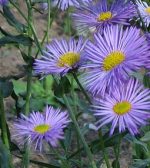 Showy fleabane, also called aspen or garden fleabane, is a herbaceous perennial native to open woods, prairies, meadows, and roadsides from Alberta and British Columbia, south to the Black Hills, New Mexico, Arizona and Oregon. A thick taproot produces a rosette of leaves and multiple flowering stems 6-20″ tall that are tinged with maroon and bear narrow leaves. The two inch wide flowerheads appear in early and midsummer and consist of numerous blue, purple, or rarely white ray flowers surrounding a mass of yellow disc flowers. USDA Hardiness Zones 4-7 (Photo Credit Wikipedia)
Showy fleabane, also called aspen or garden fleabane, is a herbaceous perennial native to open woods, prairies, meadows, and roadsides from Alberta and British Columbia, south to the Black Hills, New Mexico, Arizona and Oregon. A thick taproot produces a rosette of leaves and multiple flowering stems 6-20″ tall that are tinged with maroon and bear narrow leaves. The two inch wide flowerheads appear in early and midsummer and consist of numerous blue, purple, or rarely white ray flowers surrounding a mass of yellow disc flowers. USDA Hardiness Zones 4-7 (Photo Credit Wikipedia)
Prairie Flax (Linum lewisii)
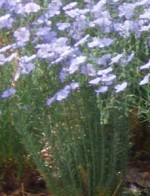 This short-lived long blooming herbaceous perennial is native to western North America where it is found on ridges and dry slopes as well as in mountain meadows and grasslands. It is 12-24″ tall, clump-forming, and has an abundance of blue, lavender, or white flowers from late spring through summer. Each cup-shaped flower is about 1 1/2″ across, has five petals with prominent veining and last for just a day, opening fully only on sunny days. The leaves are blue-green and needle-like giving the whole plant a delicate wispy look. USDA Hardiness Zones 3-8; 8-10 on West coast (Photo Credit Wikipedia)
This short-lived long blooming herbaceous perennial is native to western North America where it is found on ridges and dry slopes as well as in mountain meadows and grasslands. It is 12-24″ tall, clump-forming, and has an abundance of blue, lavender, or white flowers from late spring through summer. Each cup-shaped flower is about 1 1/2″ across, has five petals with prominent veining and last for just a day, opening fully only on sunny days. The leaves are blue-green and needle-like giving the whole plant a delicate wispy look. USDA Hardiness Zones 3-8; 8-10 on West coast (Photo Credit Wikipedia)
Lupines (Lupinus spp.)
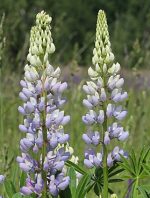 Lupines are cool weather plants and have palmately compound leaves with narrow leaflets and asymmetrical pea-like flowers carried in slender spikes or racemes. The flowers vary in color and are each comprised of an erect standard, 2 wing petals, and an incruved keel. L. polyphyllus and L. latifolius are native to the West Coast and L. perennis to the East.
Lupines are cool weather plants and have palmately compound leaves with narrow leaflets and asymmetrical pea-like flowers carried in slender spikes or racemes. The flowers vary in color and are each comprised of an erect standard, 2 wing petals, and an incruved keel. L. polyphyllus and L. latifolius are native to the West Coast and L. perennis to the East.
Rocky Mountain Beard-Tongue (Penstemon strictus)
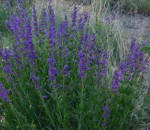 A native from southern Wyoming to Arizona where it is often associated with conifers or sagebrush, Rocky Mountain beard-tongue is an evergreen perennial with rich blue to purple flowers on 1-3’ stems rising above a low mat of foliage. The leaves are glossy and range from narrow and grass-like to long and broad. Plants spread slowly but can form large clumps. USDA Hardiness Zones 3-8 (Photo Credit Wikipedia)
A native from southern Wyoming to Arizona where it is often associated with conifers or sagebrush, Rocky Mountain beard-tongue is an evergreen perennial with rich blue to purple flowers on 1-3’ stems rising above a low mat of foliage. The leaves are glossy and range from narrow and grass-like to long and broad. Plants spread slowly but can form large clumps. USDA Hardiness Zones 3-8 (Photo Credit Wikipedia)
Jacob’s Ladder (Polemonium pulcherrimum)
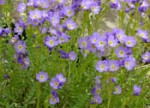 This clump forming perennial is native to western North American from Alaska to California and into Arizona and New Mexico where it grows in dry rocky areas of mountains from foothills to the alpine zones. The basal leaves are four to six inches long and divided into thirty or less leaflets in a ladder-like arrangement to give a ferny look. Flowering stems have smaller leaves and are four to eight inches tall. In late spring to early summer each stem bears a dense cluster of bell-shaped flowers, ¼” across that are usually blue with yellow centers and white stamens but can be violet or near white. USDA Hardiness Zones 3-8 (Photo Credit Wikipedia)
This clump forming perennial is native to western North American from Alaska to California and into Arizona and New Mexico where it grows in dry rocky areas of mountains from foothills to the alpine zones. The basal leaves are four to six inches long and divided into thirty or less leaflets in a ladder-like arrangement to give a ferny look. Flowering stems have smaller leaves and are four to eight inches tall. In late spring to early summer each stem bears a dense cluster of bell-shaped flowers, ¼” across that are usually blue with yellow centers and white stamens but can be violet or near white. USDA Hardiness Zones 3-8 (Photo Credit Wikipedia)
Common Wood Aster (Aster cordifolius aka Symphyotrichum cordifolium)
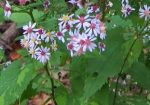 Also known as heart-leaved aster or blue wood aster, this clumping herbaceous perennial is a member of the aster family, Asteraceeae. that also includes sunflower, daisy, and lettuce. It is native to North America from Nova Scotia to Ontario, south to Georgia and Kansas where it grows in open woods, clearings, woodland edges, meadows, fields, and stream banks but can also be found in disturbed sites such as roadsides. Plants grow up to 2′-5- tall from a rhizomatous root system and has branched stems carrying five” long lanceolate lower leaves with coarsely toothed margins and heart-shaped bases. Upper leaves are smaller and ovate. In late summer and early autumn branched panicles of flowerheads appear. Each flowerhead is 1/2″-3/4″ across and is comprised of white to blue ray flowers surrounding a center of yellow disc flowers. The flowers are attractive to bees and butterflies. USDA Hardiness Zones 3-8 (Photo Credit Wikipedia)
Also known as heart-leaved aster or blue wood aster, this clumping herbaceous perennial is a member of the aster family, Asteraceeae. that also includes sunflower, daisy, and lettuce. It is native to North America from Nova Scotia to Ontario, south to Georgia and Kansas where it grows in open woods, clearings, woodland edges, meadows, fields, and stream banks but can also be found in disturbed sites such as roadsides. Plants grow up to 2′-5- tall from a rhizomatous root system and has branched stems carrying five” long lanceolate lower leaves with coarsely toothed margins and heart-shaped bases. Upper leaves are smaller and ovate. In late summer and early autumn branched panicles of flowerheads appear. Each flowerhead is 1/2″-3/4″ across and is comprised of white to blue ray flowers surrounding a center of yellow disc flowers. The flowers are attractive to bees and butterflies. USDA Hardiness Zones 3-8 (Photo Credit Wikipedia)